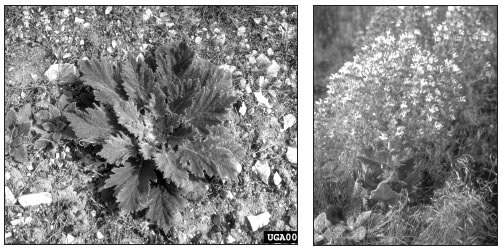There’s a new weed in town — and it’s kind of a bully.
Mediterranean sage, an invasive ornamental plant, has popped up in Montezuma County on Road 30, 1 mile south of Highway 184. It was spotted in July by Kirk Swope, a county weed technician, who owns a piece of property that has been invaded by the plant. How the noxious weed came here remains a mystery.
Swope said the sage is also present on the property of his neighbors across the road, who came from Monte Vista, Colo., bringing cows and hay with them, so there has been speculation that perhaps the seeds were present in the hay. However, no one has found the weed yet in Monte Vista, “so we’re not sure that’s how it got there at all,” Swope said.

Mediterranean sage, an invasive noxious weed spotted recently in Montezuma County, has large, woolly, aromatic leaves and produces showy white flowers. The plant is sometimes sold as Ethiopian sage in nurseries, according to the Colorado Weed Management Association. Plants grow to 2-3 feet in height. Photo on the left by Lloyd Andres/USDA Photo on the right by Eric Coombs/Oregon Dept. of Ag.
In fact, Montezuma County has the dubious distinction of being only the second site in Colorado where Mediterranean sage has been found — the other being Boulder County, where the plant has taken over 400 acres.
Swope said the sage is considered a threat because it is “very invasive and hard to kll, as most weeds are.” A biennial or short-lived perennial, it produces up to 100,000 seeds per plant. Furthermore, he said, “Most of the chemicals it takes to kill it, you have to be a licensed operator to buy. So we’re really trying to knock it out.”
Swope said Montezuma County Weed Program Supervisor Don Morris spent two weeks cutting and sacking the plants found along Road 30.
He said he hopes that people will be on the lookout for Mediterranean sage and will contact the weed program if they think they spy it. “We want to catch it so it won’t turn into a Canada thistle, that’s everywhere,” Swope said.
Weeds are a perennial (no pun intended) problem in the region and across the West. It is estimated that 10 percent of Colorado’s native plants have been replaced by noxious weeds, and on Western public lands weeds are spreading at about 4,600 acres per day, according to estimates by federal land managers.
Noxious weeds are a serious problem because they drive out the native plants upon which wild animals depend and compete with agricultural crops, costing farmers and ranchers money. Some weeds actually create their own toxic chemicals that prevent other plants and grass from growing near them; others have root systems that starve out native species; and some simply reproduce so rapidly that they can win the race against all competitors.
Once established, noxious weeds can lower the value of one’s own property and can spread to neighbors’ land.
In Montezuma County, Canada thistle, musk thistle, and knapweed are among the most troublesome invaders.
Swope said hoary cress, or whitetop, also “for some reason really came on this year,” perhaps because of the early moisture.
There are several options for controlling noxious weeds:
• Chemicals. Local farm stores have a variety of chemicals, and nurseries often have organic sprays as well.
• Insects. Biological control agents “have some value but are not good to rely on for quick control,” said Morris. Still, they can stress the invaders and slow them down, and are generally safe to use. The Division of Plant Industry Insectary has a variety of insects available for specific weeds. Call 866-324- 2963 or see www.ag.state.co.us/ dpi/insectary/bpcs.html.
• Cutting. Chopping off whole plants at the base before they flower will keep the plants from going to seed, if done regularly. However, it won’t get rid of the original plants. The Montezuma County Weed Program offers a program that will reimburse property owners within the county for half the cost of their chemical or biological controls per year, up to $250.
Swope said not a lot of people have taken advantage of the program so far this summer.
“The money’s there, so people should contact us,” he said.








